Marketing Management Report: Marketing Strategies at Sainsbury's
VerifiedAdded on 2022/12/29
|12
|3770
|38
Report
AI Summary
This report provides a detailed analysis of Sainsbury's marketing management, exploring the role of data in enhancing relationship marketing and improving customer expectations and service excellence. It examines how data is utilized to understand customer behavior, predict their needs, and provide relevant information, ultimately leading to improved customer engagement and service. The report includes an STP (Segmentation, Targeting, Positioning) analysis of Sainsbury's products and services, outlining segmentation strategies, target customer groups, and positioning within the market. Furthermore, it explores the rationale for meeting customer needs through innovation in product and service design, considering the impact of factors like COVID-19 and Brexit. The report concludes with recommendations for specific targeting of customer groups and their effective needs fulfillment, offering insights into Sainsbury's marketing strategies and their impact on business performance and customer satisfaction.

Marketing
Management
Management
Paraphrase This Document
Need a fresh take? Get an instant paraphrase of this document with our AI Paraphraser
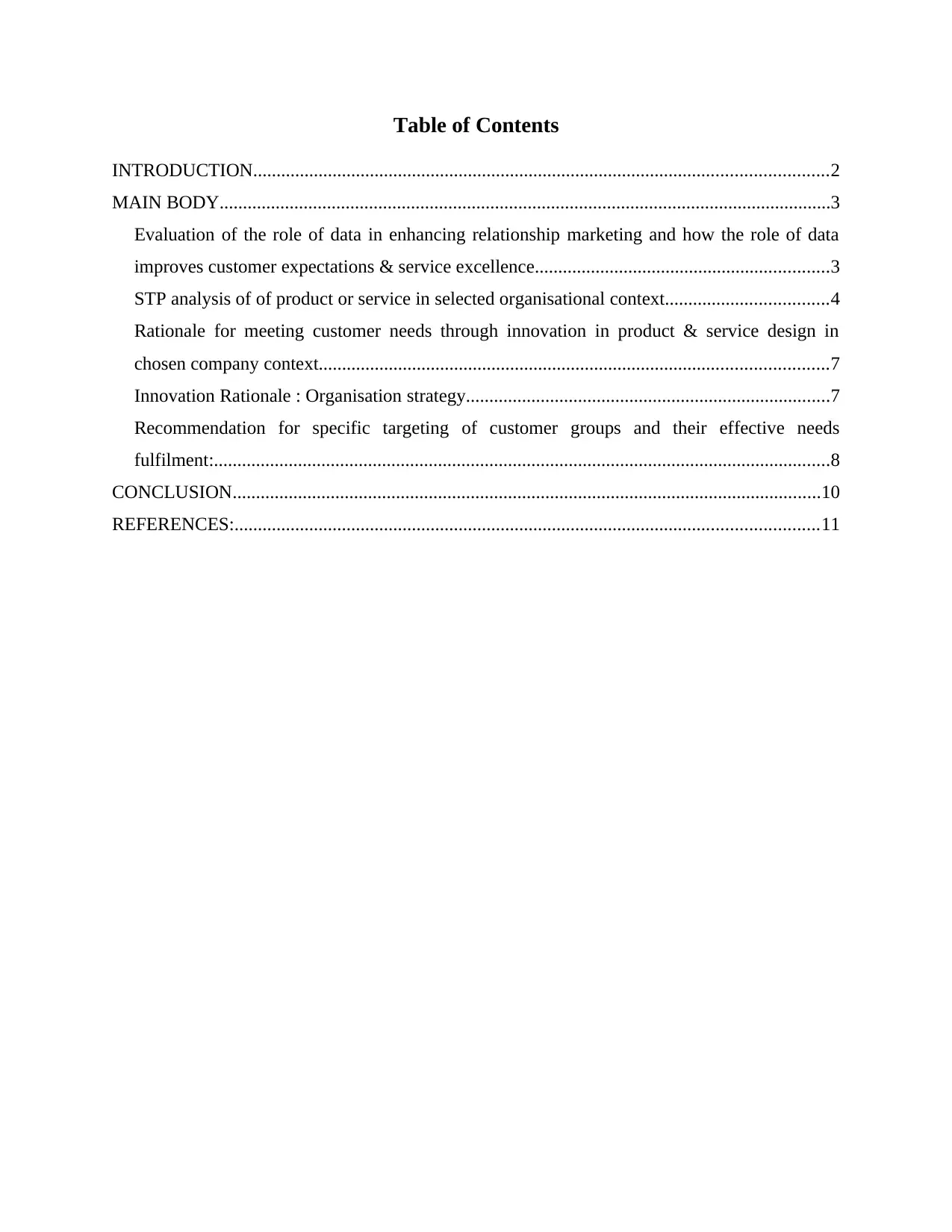
Table of Contents
INTRODUCTION...........................................................................................................................2
MAIN BODY...................................................................................................................................3
Evaluation of the role of data in enhancing relationship marketing and how the role of data
improves customer expectations & service excellence...............................................................3
STP analysis of of product or service in selected organisational context...................................4
Rationale for meeting customer needs through innovation in product & service design in
chosen company context.............................................................................................................7
Innovation Rationale : Organisation strategy..............................................................................7
Recommendation for specific targeting of customer groups and their effective needs
fulfilment:....................................................................................................................................8
CONCLUSION..............................................................................................................................10
REFERENCES:.............................................................................................................................11
INTRODUCTION...........................................................................................................................2
MAIN BODY...................................................................................................................................3
Evaluation of the role of data in enhancing relationship marketing and how the role of data
improves customer expectations & service excellence...............................................................3
STP analysis of of product or service in selected organisational context...................................4
Rationale for meeting customer needs through innovation in product & service design in
chosen company context.............................................................................................................7
Innovation Rationale : Organisation strategy..............................................................................7
Recommendation for specific targeting of customer groups and their effective needs
fulfilment:....................................................................................................................................8
CONCLUSION..............................................................................................................................10
REFERENCES:.............................................................................................................................11

INTRODUCTION
Marketing management is the organisational discipline that emphasis on the practical
application of marketing methods, techniques and orientation inside enterprise & on the
management of a company's marketing activities as well as resources. In addition to this, it is the
procedure adopted to analyse what products & services may be of customers interest and the
strategy to use in business as well as sales development (Bagozzi and et. al., 2018). For the
present report, Sainsbury's is chosen as a base company. It is the second largest chain of
supermarkets in UK and was founded in year 1869. It offers product and services in more than
19 countries and has around 1450 shops globally that shows it has high market presence. The
report will cover the role of data in enhancing relationship marketing and how it improves
service excellence and customer experience. Along with this, the concept of STP of a particular
product is described. Moreover, there is development for innovation in product & service design
in fulfilling the customers requirements. In the last, some viable solutions is given in order to
improve and meet with customer requirements.
MAIN BODY
Evaluation of the role of data in enhancing relationship marketing and how the role of data
improves customer expectations & service excellence
Data referred to the set of collection information that is in the form of both qualitative
and quantitative gathered through various sources such as observation, questionnaire, secondary
sources and so on. to In the present time period, data is becoming a significant part of marketing
and companies are focus on collecting more information about customers and its performance as
well (Chernev, 2018). This data assist organisation to make improvements within their goods,
marketing and customer service as well. Marketers required to connect with people in order to
form business as they are one of the major reason of its success and failure as well.
In relation to the respective organisation, it is analysed that data help in tracking the
behaviour of customers towards the brand and allow them to know whether customer is satisfied
or not with the brand. Along with this, it assist Sainsbury's to see the world from the perspective
of large number of customers that ultimately drives and improves customer engagement and
services as well. Moreover, it assist businesses to develop value as well as track trends. It is
Marketing management is the organisational discipline that emphasis on the practical
application of marketing methods, techniques and orientation inside enterprise & on the
management of a company's marketing activities as well as resources. In addition to this, it is the
procedure adopted to analyse what products & services may be of customers interest and the
strategy to use in business as well as sales development (Bagozzi and et. al., 2018). For the
present report, Sainsbury's is chosen as a base company. It is the second largest chain of
supermarkets in UK and was founded in year 1869. It offers product and services in more than
19 countries and has around 1450 shops globally that shows it has high market presence. The
report will cover the role of data in enhancing relationship marketing and how it improves
service excellence and customer experience. Along with this, the concept of STP of a particular
product is described. Moreover, there is development for innovation in product & service design
in fulfilling the customers requirements. In the last, some viable solutions is given in order to
improve and meet with customer requirements.
MAIN BODY
Evaluation of the role of data in enhancing relationship marketing and how the role of data
improves customer expectations & service excellence
Data referred to the set of collection information that is in the form of both qualitative
and quantitative gathered through various sources such as observation, questionnaire, secondary
sources and so on. to In the present time period, data is becoming a significant part of marketing
and companies are focus on collecting more information about customers and its performance as
well (Chernev, 2018). This data assist organisation to make improvements within their goods,
marketing and customer service as well. Marketers required to connect with people in order to
form business as they are one of the major reason of its success and failure as well.
In relation to the respective organisation, it is analysed that data help in tracking the
behaviour of customers towards the brand and allow them to know whether customer is satisfied
or not with the brand. Along with this, it assist Sainsbury's to see the world from the perspective
of large number of customers that ultimately drives and improves customer engagement and
services as well. Moreover, it assist businesses to develop value as well as track trends. It is
⊘ This is a preview!⊘
Do you want full access?
Subscribe today to unlock all pages.

Trusted by 1+ million students worldwide
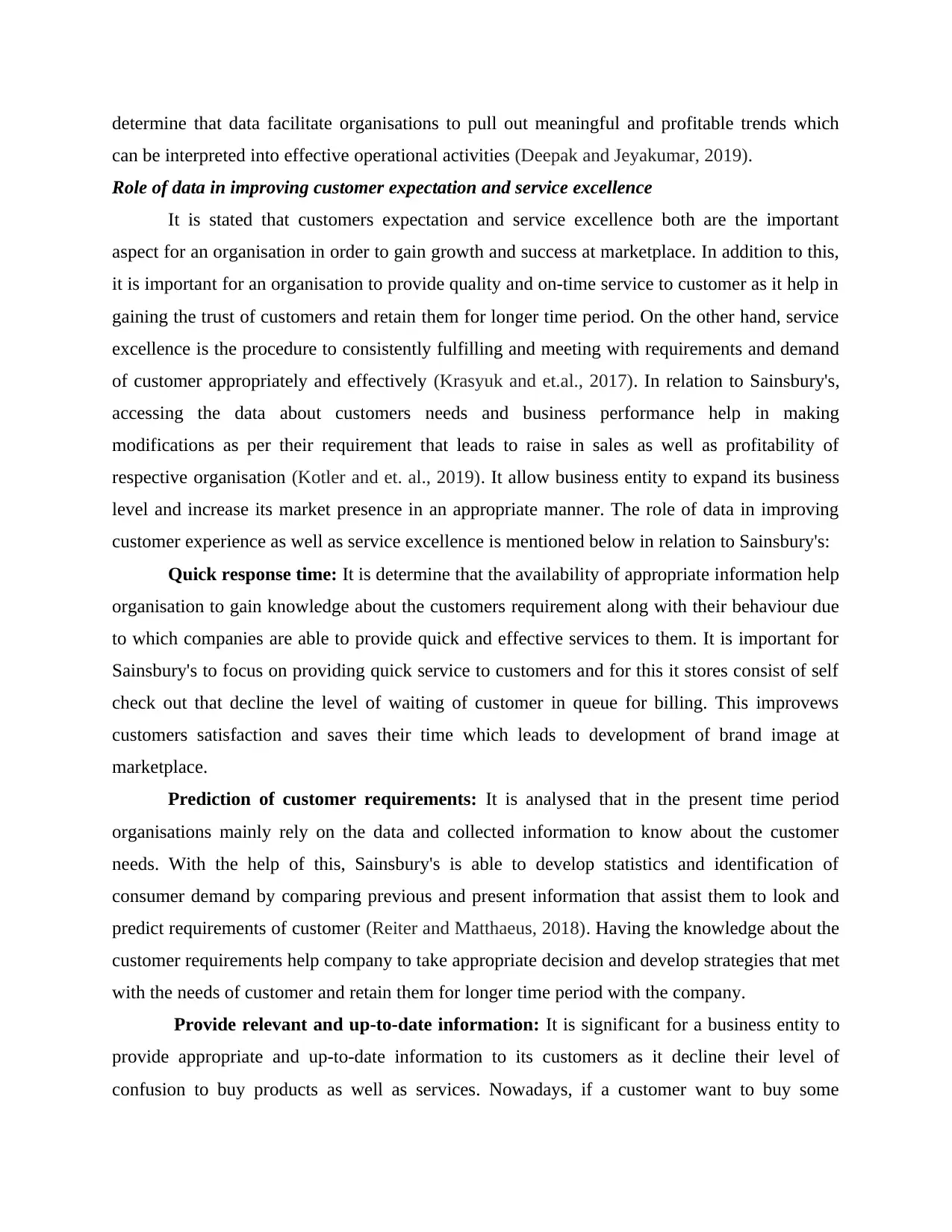
determine that data facilitate organisations to pull out meaningful and profitable trends which
can be interpreted into effective operational activities (Deepak and Jeyakumar, 2019).
Role of data in improving customer expectation and service excellence
It is stated that customers expectation and service excellence both are the important
aspect for an organisation in order to gain growth and success at marketplace. In addition to this,
it is important for an organisation to provide quality and on-time service to customer as it help in
gaining the trust of customers and retain them for longer time period. On the other hand, service
excellence is the procedure to consistently fulfilling and meeting with requirements and demand
of customer appropriately and effectively (Krasyuk and et.al., 2017). In relation to Sainsbury's,
accessing the data about customers needs and business performance help in making
modifications as per their requirement that leads to raise in sales as well as profitability of
respective organisation (Kotler and et. al., 2019). It allow business entity to expand its business
level and increase its market presence in an appropriate manner. The role of data in improving
customer experience as well as service excellence is mentioned below in relation to Sainsbury's:
Quick response time: It is determine that the availability of appropriate information help
organisation to gain knowledge about the customers requirement along with their behaviour due
to which companies are able to provide quick and effective services to them. It is important for
Sainsbury's to focus on providing quick service to customers and for this it stores consist of self
check out that decline the level of waiting of customer in queue for billing. This improvews
customers satisfaction and saves their time which leads to development of brand image at
marketplace.
Prediction of customer requirements: It is analysed that in the present time period
organisations mainly rely on the data and collected information to know about the customer
needs. With the help of this, Sainsbury's is able to develop statistics and identification of
consumer demand by comparing previous and present information that assist them to look and
predict requirements of customer (Reiter and Matthaeus, 2018). Having the knowledge about the
customer requirements help company to take appropriate decision and develop strategies that met
with the needs of customer and retain them for longer time period with the company.
Provide relevant and up-to-date information: It is significant for a business entity to
provide appropriate and up-to-date information to its customers as it decline their level of
confusion to buy products as well as services. Nowadays, if a customer want to buy some
can be interpreted into effective operational activities (Deepak and Jeyakumar, 2019).
Role of data in improving customer expectation and service excellence
It is stated that customers expectation and service excellence both are the important
aspect for an organisation in order to gain growth and success at marketplace. In addition to this,
it is important for an organisation to provide quality and on-time service to customer as it help in
gaining the trust of customers and retain them for longer time period. On the other hand, service
excellence is the procedure to consistently fulfilling and meeting with requirements and demand
of customer appropriately and effectively (Krasyuk and et.al., 2017). In relation to Sainsbury's,
accessing the data about customers needs and business performance help in making
modifications as per their requirement that leads to raise in sales as well as profitability of
respective organisation (Kotler and et. al., 2019). It allow business entity to expand its business
level and increase its market presence in an appropriate manner. The role of data in improving
customer experience as well as service excellence is mentioned below in relation to Sainsbury's:
Quick response time: It is determine that the availability of appropriate information help
organisation to gain knowledge about the customers requirement along with their behaviour due
to which companies are able to provide quick and effective services to them. It is important for
Sainsbury's to focus on providing quick service to customers and for this it stores consist of self
check out that decline the level of waiting of customer in queue for billing. This improvews
customers satisfaction and saves their time which leads to development of brand image at
marketplace.
Prediction of customer requirements: It is analysed that in the present time period
organisations mainly rely on the data and collected information to know about the customer
needs. With the help of this, Sainsbury's is able to develop statistics and identification of
consumer demand by comparing previous and present information that assist them to look and
predict requirements of customer (Reiter and Matthaeus, 2018). Having the knowledge about the
customer requirements help company to take appropriate decision and develop strategies that met
with the needs of customer and retain them for longer time period with the company.
Provide relevant and up-to-date information: It is significant for a business entity to
provide appropriate and up-to-date information to its customers as it decline their level of
confusion to buy products as well as services. Nowadays, if a customer want to buy some
Paraphrase This Document
Need a fresh take? Get an instant paraphrase of this document with our AI Paraphraser
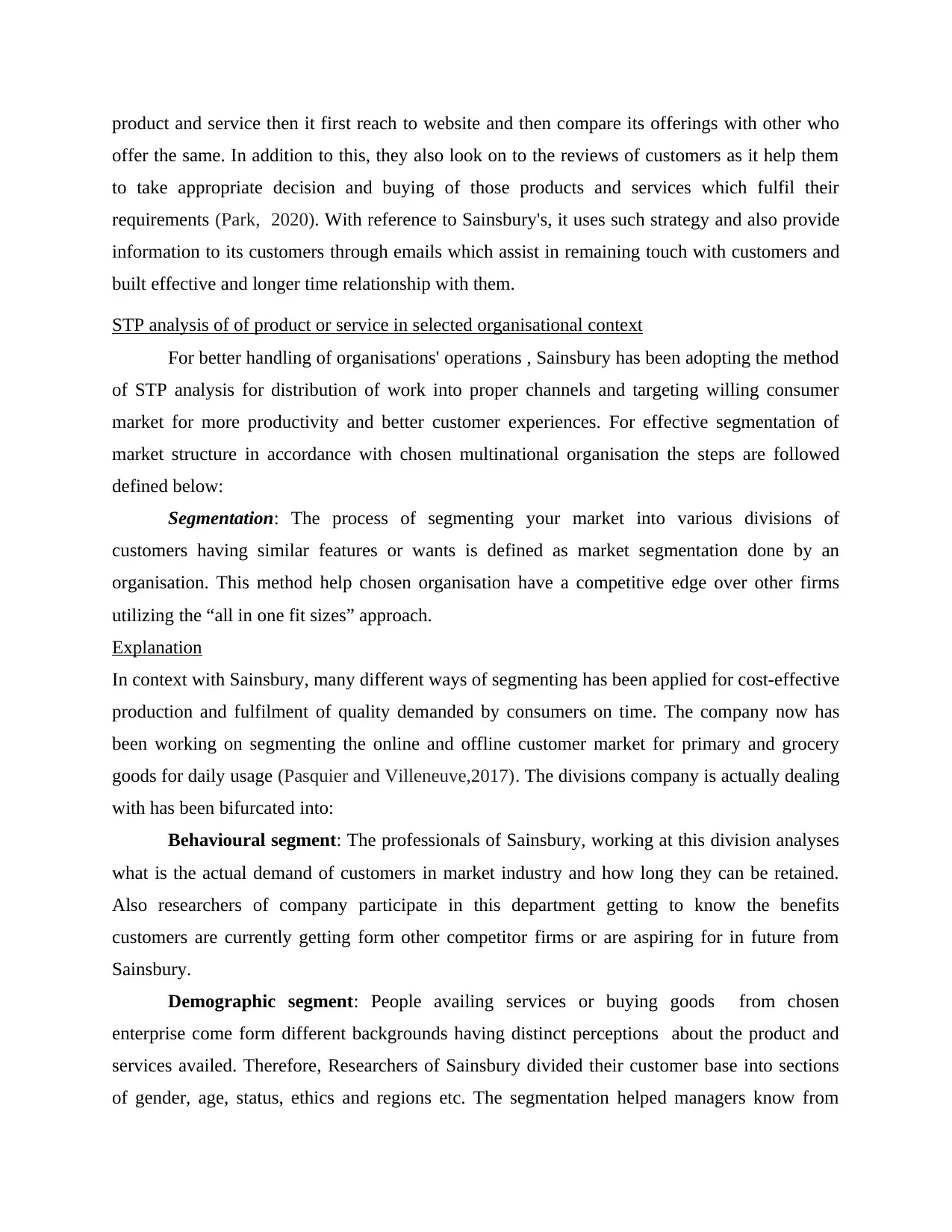
product and service then it first reach to website and then compare its offerings with other who
offer the same. In addition to this, they also look on to the reviews of customers as it help them
to take appropriate decision and buying of those products and services which fulfil their
requirements (Park, 2020). With reference to Sainsbury's, it uses such strategy and also provide
information to its customers through emails which assist in remaining touch with customers and
built effective and longer time relationship with them.
STP analysis of of product or service in selected organisational context
For better handling of organisations' operations , Sainsbury has been adopting the method
of STP analysis for distribution of work into proper channels and targeting willing consumer
market for more productivity and better customer experiences. For effective segmentation of
market structure in accordance with chosen multinational organisation the steps are followed
defined below:
Segmentation: The process of segmenting your market into various divisions of
customers having similar features or wants is defined as market segmentation done by an
organisation. This method help chosen organisation have a competitive edge over other firms
utilizing the “all in one fit sizes” approach.
Explanation
In context with Sainsbury, many different ways of segmenting has been applied for cost-effective
production and fulfilment of quality demanded by consumers on time. The company now has
been working on segmenting the online and offline customer market for primary and grocery
goods for daily usage (Pasquier and Villeneuve,2017). The divisions company is actually dealing
with has been bifurcated into:
Behavioural segment: The professionals of Sainsbury, working at this division analyses
what is the actual demand of customers in market industry and how long they can be retained.
Also researchers of company participate in this department getting to know the benefits
customers are currently getting form other competitor firms or are aspiring for in future from
Sainsbury.
Demographic segment: People availing services or buying goods from chosen
enterprise come form different backgrounds having distinct perceptions about the product and
services availed. Therefore, Researchers of Sainsbury divided their customer base into sections
of gender, age, status, ethics and regions etc. The segmentation helped managers know from
offer the same. In addition to this, they also look on to the reviews of customers as it help them
to take appropriate decision and buying of those products and services which fulfil their
requirements (Park, 2020). With reference to Sainsbury's, it uses such strategy and also provide
information to its customers through emails which assist in remaining touch with customers and
built effective and longer time relationship with them.
STP analysis of of product or service in selected organisational context
For better handling of organisations' operations , Sainsbury has been adopting the method
of STP analysis for distribution of work into proper channels and targeting willing consumer
market for more productivity and better customer experiences. For effective segmentation of
market structure in accordance with chosen multinational organisation the steps are followed
defined below:
Segmentation: The process of segmenting your market into various divisions of
customers having similar features or wants is defined as market segmentation done by an
organisation. This method help chosen organisation have a competitive edge over other firms
utilizing the “all in one fit sizes” approach.
Explanation
In context with Sainsbury, many different ways of segmenting has been applied for cost-effective
production and fulfilment of quality demanded by consumers on time. The company now has
been working on segmenting the online and offline customer market for primary and grocery
goods for daily usage (Pasquier and Villeneuve,2017). The divisions company is actually dealing
with has been bifurcated into:
Behavioural segment: The professionals of Sainsbury, working at this division analyses
what is the actual demand of customers in market industry and how long they can be retained.
Also researchers of company participate in this department getting to know the benefits
customers are currently getting form other competitor firms or are aspiring for in future from
Sainsbury.
Demographic segment: People availing services or buying goods from chosen
enterprise come form different backgrounds having distinct perceptions about the product and
services availed. Therefore, Researchers of Sainsbury divided their customer base into sections
of gender, age, status, ethics and regions etc. The segmentation helped managers know from
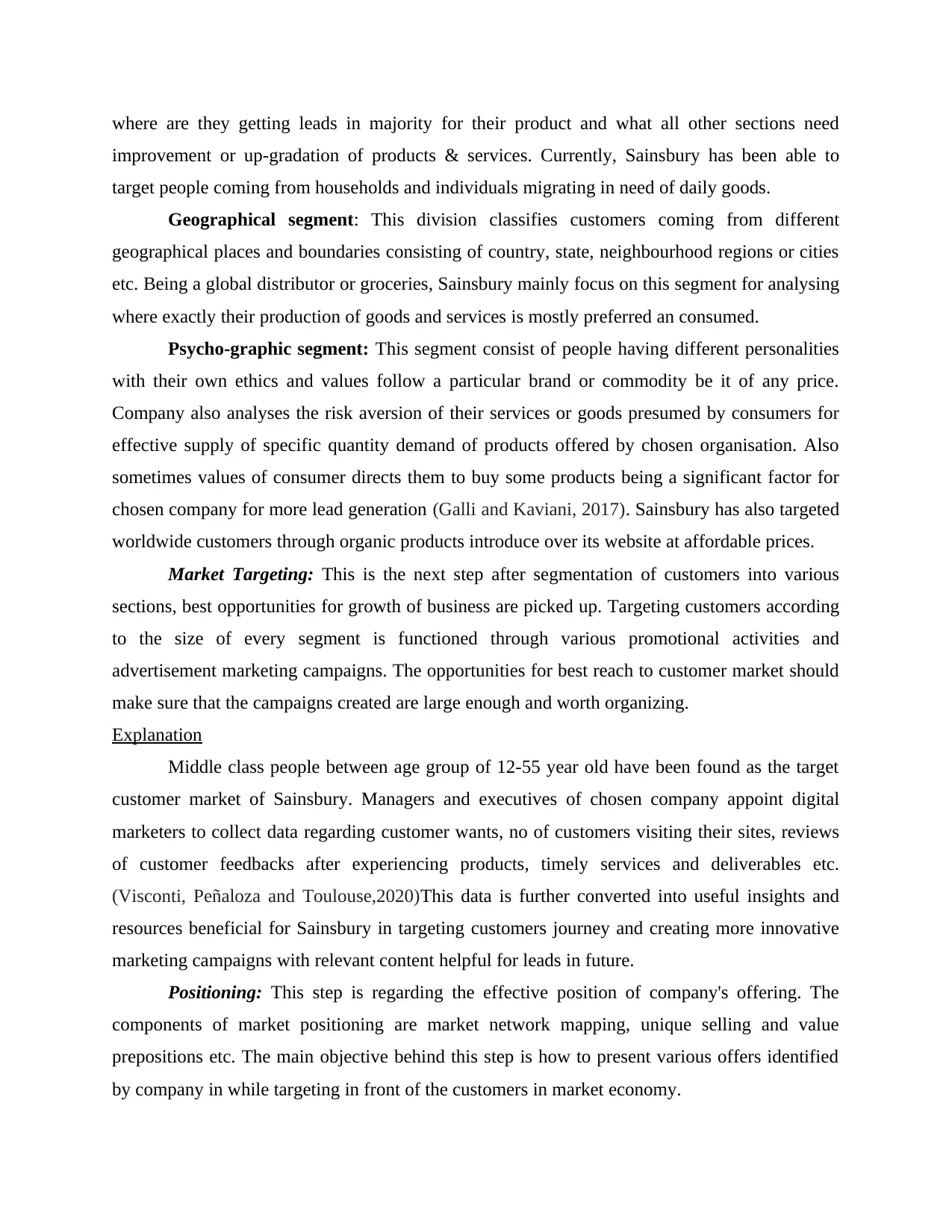
where are they getting leads in majority for their product and what all other sections need
improvement or up-gradation of products & services. Currently, Sainsbury has been able to
target people coming from households and individuals migrating in need of daily goods.
Geographical segment: This division classifies customers coming from different
geographical places and boundaries consisting of country, state, neighbourhood regions or cities
etc. Being a global distributor or groceries, Sainsbury mainly focus on this segment for analysing
where exactly their production of goods and services is mostly preferred an consumed.
Psycho-graphic segment: This segment consist of people having different personalities
with their own ethics and values follow a particular brand or commodity be it of any price.
Company also analyses the risk aversion of their services or goods presumed by consumers for
effective supply of specific quantity demand of products offered by chosen organisation. Also
sometimes values of consumer directs them to buy some products being a significant factor for
chosen company for more lead generation (Galli and Kaviani, 2017). Sainsbury has also targeted
worldwide customers through organic products introduce over its website at affordable prices.
Market Targeting: This is the next step after segmentation of customers into various
sections, best opportunities for growth of business are picked up. Targeting customers according
to the size of every segment is functioned through various promotional activities and
advertisement marketing campaigns. The opportunities for best reach to customer market should
make sure that the campaigns created are large enough and worth organizing.
Explanation
Middle class people between age group of 12-55 year old have been found as the target
customer market of Sainsbury. Managers and executives of chosen company appoint digital
marketers to collect data regarding customer wants, no of customers visiting their sites, reviews
of customer feedbacks after experiencing products, timely services and deliverables etc.
(Visconti, Peñaloza and Toulouse,2020)This data is further converted into useful insights and
resources beneficial for Sainsbury in targeting customers journey and creating more innovative
marketing campaigns with relevant content helpful for leads in future.
Positioning: This step is regarding the effective position of company's offering. The
components of market positioning are market network mapping, unique selling and value
prepositions etc. The main objective behind this step is how to present various offers identified
by company in while targeting in front of the customers in market economy.
improvement or up-gradation of products & services. Currently, Sainsbury has been able to
target people coming from households and individuals migrating in need of daily goods.
Geographical segment: This division classifies customers coming from different
geographical places and boundaries consisting of country, state, neighbourhood regions or cities
etc. Being a global distributor or groceries, Sainsbury mainly focus on this segment for analysing
where exactly their production of goods and services is mostly preferred an consumed.
Psycho-graphic segment: This segment consist of people having different personalities
with their own ethics and values follow a particular brand or commodity be it of any price.
Company also analyses the risk aversion of their services or goods presumed by consumers for
effective supply of specific quantity demand of products offered by chosen organisation. Also
sometimes values of consumer directs them to buy some products being a significant factor for
chosen company for more lead generation (Galli and Kaviani, 2017). Sainsbury has also targeted
worldwide customers through organic products introduce over its website at affordable prices.
Market Targeting: This is the next step after segmentation of customers into various
sections, best opportunities for growth of business are picked up. Targeting customers according
to the size of every segment is functioned through various promotional activities and
advertisement marketing campaigns. The opportunities for best reach to customer market should
make sure that the campaigns created are large enough and worth organizing.
Explanation
Middle class people between age group of 12-55 year old have been found as the target
customer market of Sainsbury. Managers and executives of chosen company appoint digital
marketers to collect data regarding customer wants, no of customers visiting their sites, reviews
of customer feedbacks after experiencing products, timely services and deliverables etc.
(Visconti, Peñaloza and Toulouse,2020)This data is further converted into useful insights and
resources beneficial for Sainsbury in targeting customers journey and creating more innovative
marketing campaigns with relevant content helpful for leads in future.
Positioning: This step is regarding the effective position of company's offering. The
components of market positioning are market network mapping, unique selling and value
prepositions etc. The main objective behind this step is how to present various offers identified
by company in while targeting in front of the customers in market economy.
⊘ This is a preview!⊘
Do you want full access?
Subscribe today to unlock all pages.

Trusted by 1+ million students worldwide
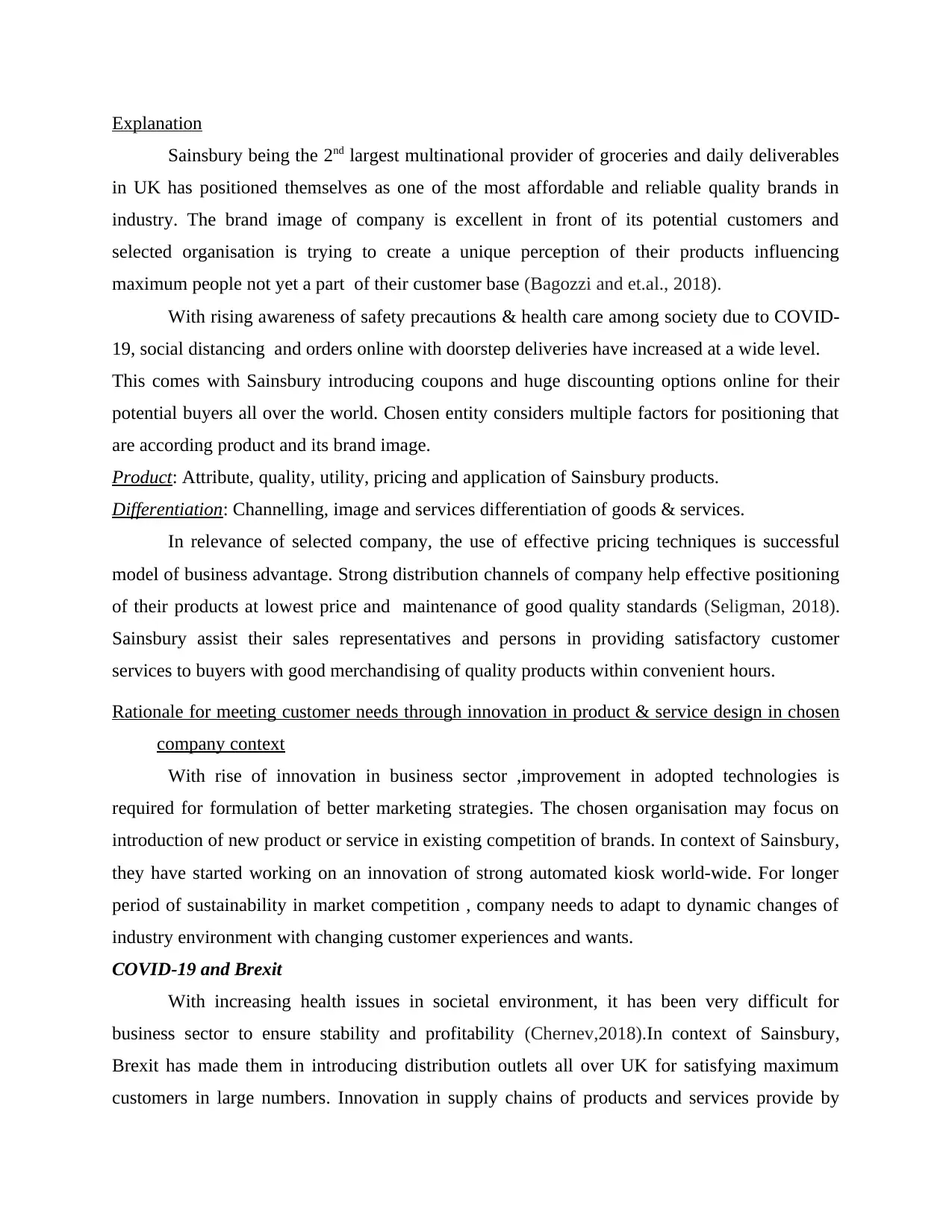
Explanation
Sainsbury being the 2nd largest multinational provider of groceries and daily deliverables
in UK has positioned themselves as one of the most affordable and reliable quality brands in
industry. The brand image of company is excellent in front of its potential customers and
selected organisation is trying to create a unique perception of their products influencing
maximum people not yet a part of their customer base (Bagozzi and et.al., 2018).
With rising awareness of safety precautions & health care among society due to COVID-
19, social distancing and orders online with doorstep deliveries have increased at a wide level.
This comes with Sainsbury introducing coupons and huge discounting options online for their
potential buyers all over the world. Chosen entity considers multiple factors for positioning that
are according product and its brand image.
Product: Attribute, quality, utility, pricing and application of Sainsbury products.
Differentiation: Channelling, image and services differentiation of goods & services.
In relevance of selected company, the use of effective pricing techniques is successful
model of business advantage. Strong distribution channels of company help effective positioning
of their products at lowest price and maintenance of good quality standards (Seligman, 2018).
Sainsbury assist their sales representatives and persons in providing satisfactory customer
services to buyers with good merchandising of quality products within convenient hours.
Rationale for meeting customer needs through innovation in product & service design in chosen
company context
With rise of innovation in business sector ,improvement in adopted technologies is
required for formulation of better marketing strategies. The chosen organisation may focus on
introduction of new product or service in existing competition of brands. In context of Sainsbury,
they have started working on an innovation of strong automated kiosk world-wide. For longer
period of sustainability in market competition , company needs to adapt to dynamic changes of
industry environment with changing customer experiences and wants.
COVID-19 and Brexit
With increasing health issues in societal environment, it has been very difficult for
business sector to ensure stability and profitability (Chernev,2018).In context of Sainsbury,
Brexit has made them in introducing distribution outlets all over UK for satisfying maximum
customers in large numbers. Innovation in supply chains of products and services provide by
Sainsbury being the 2nd largest multinational provider of groceries and daily deliverables
in UK has positioned themselves as one of the most affordable and reliable quality brands in
industry. The brand image of company is excellent in front of its potential customers and
selected organisation is trying to create a unique perception of their products influencing
maximum people not yet a part of their customer base (Bagozzi and et.al., 2018).
With rising awareness of safety precautions & health care among society due to COVID-
19, social distancing and orders online with doorstep deliveries have increased at a wide level.
This comes with Sainsbury introducing coupons and huge discounting options online for their
potential buyers all over the world. Chosen entity considers multiple factors for positioning that
are according product and its brand image.
Product: Attribute, quality, utility, pricing and application of Sainsbury products.
Differentiation: Channelling, image and services differentiation of goods & services.
In relevance of selected company, the use of effective pricing techniques is successful
model of business advantage. Strong distribution channels of company help effective positioning
of their products at lowest price and maintenance of good quality standards (Seligman, 2018).
Sainsbury assist their sales representatives and persons in providing satisfactory customer
services to buyers with good merchandising of quality products within convenient hours.
Rationale for meeting customer needs through innovation in product & service design in chosen
company context
With rise of innovation in business sector ,improvement in adopted technologies is
required for formulation of better marketing strategies. The chosen organisation may focus on
introduction of new product or service in existing competition of brands. In context of Sainsbury,
they have started working on an innovation of strong automated kiosk world-wide. For longer
period of sustainability in market competition , company needs to adapt to dynamic changes of
industry environment with changing customer experiences and wants.
COVID-19 and Brexit
With increasing health issues in societal environment, it has been very difficult for
business sector to ensure stability and profitability (Chernev,2018).In context of Sainsbury,
Brexit has made them in introducing distribution outlets all over UK for satisfying maximum
customers in large numbers. Innovation in supply chains of products and services provide by
Paraphrase This Document
Need a fresh take? Get an instant paraphrase of this document with our AI Paraphraser

chosen company became essential for fulfilling every individual needs at the same time. COVID-
19 becoming a threat to traditional organisational structures build now needs innovation of
healthy products and safe services attracting maximum consumers.
Innovation Rationale : Organisation strategy
Rational to huge distribution channels of Sainsbury Kiosk, is minimum time wastage of
consumers through introduction of self-checkout machines. The technology will help chosen
organisation in opening up of stores that may run 24*7 (Blythe,2017).This initiative will result in
boosting maximum sales, promotion and availability of goods and services whole day & night.
New partnerships: For expansion of Sainsbury outlets at a global level and promoting the
idea of 24*7 self checkout machines , new partnerships with middle-sized enterprises for
effective functioning is essential. Joint ventures formed with enterprises around the world will
help current company explore new markets and identify emerging trends within growing
organisations.
New economies: Developing countries like Africa, Asia and India etc. are a great chance
for Sainsbury to expand. Expansion in their market by providing services such as 24*7
availability of grocery and other daily essentials will help chosen company create a monopoly
over other competitors of market. This competitive advantage in developing countries will not
only increase customer awareness but also bring good profitability to chosen organisation.
New technology and promotion: Technology of 24*7 self checkout machines innovation
will help entry of more customers in the supermarket outlets everywhere at will help n reducing
long customer queues at exit gates . Also further up-gradation of these machines may come with
automatic online wide variety payments at billing counters making it more time saving and
quick. Online transactions at various stores of Sainsbury will also become more customer
friendly in future because of rising COVID-19 conditions.
Recommendation for specific targeting of customer groups and their effective needs fulfilment:
As per current business environment, set objectives and functions are essential for
carrying out any business activities. For this, formulation of strategies to compete others in
market will help resolve rising conflicts and challenges at Sainsbury. Therefore chosen firm
focusses mainly on introducing new technologies and creating innovative ideas for targeting
maximum customers with minimum resources efficiently. Given below are some of the strategic
solutions that Sainsbury may adopt or have adopted for effective functioning of the organisation:
19 becoming a threat to traditional organisational structures build now needs innovation of
healthy products and safe services attracting maximum consumers.
Innovation Rationale : Organisation strategy
Rational to huge distribution channels of Sainsbury Kiosk, is minimum time wastage of
consumers through introduction of self-checkout machines. The technology will help chosen
organisation in opening up of stores that may run 24*7 (Blythe,2017).This initiative will result in
boosting maximum sales, promotion and availability of goods and services whole day & night.
New partnerships: For expansion of Sainsbury outlets at a global level and promoting the
idea of 24*7 self checkout machines , new partnerships with middle-sized enterprises for
effective functioning is essential. Joint ventures formed with enterprises around the world will
help current company explore new markets and identify emerging trends within growing
organisations.
New economies: Developing countries like Africa, Asia and India etc. are a great chance
for Sainsbury to expand. Expansion in their market by providing services such as 24*7
availability of grocery and other daily essentials will help chosen company create a monopoly
over other competitors of market. This competitive advantage in developing countries will not
only increase customer awareness but also bring good profitability to chosen organisation.
New technology and promotion: Technology of 24*7 self checkout machines innovation
will help entry of more customers in the supermarket outlets everywhere at will help n reducing
long customer queues at exit gates . Also further up-gradation of these machines may come with
automatic online wide variety payments at billing counters making it more time saving and
quick. Online transactions at various stores of Sainsbury will also become more customer
friendly in future because of rising COVID-19 conditions.
Recommendation for specific targeting of customer groups and their effective needs fulfilment:
As per current business environment, set objectives and functions are essential for
carrying out any business activities. For this, formulation of strategies to compete others in
market will help resolve rising conflicts and challenges at Sainsbury. Therefore chosen firm
focusses mainly on introducing new technologies and creating innovative ideas for targeting
maximum customers with minimum resources efficiently. Given below are some of the strategic
solutions that Sainsbury may adopt or have adopted for effective functioning of the organisation:
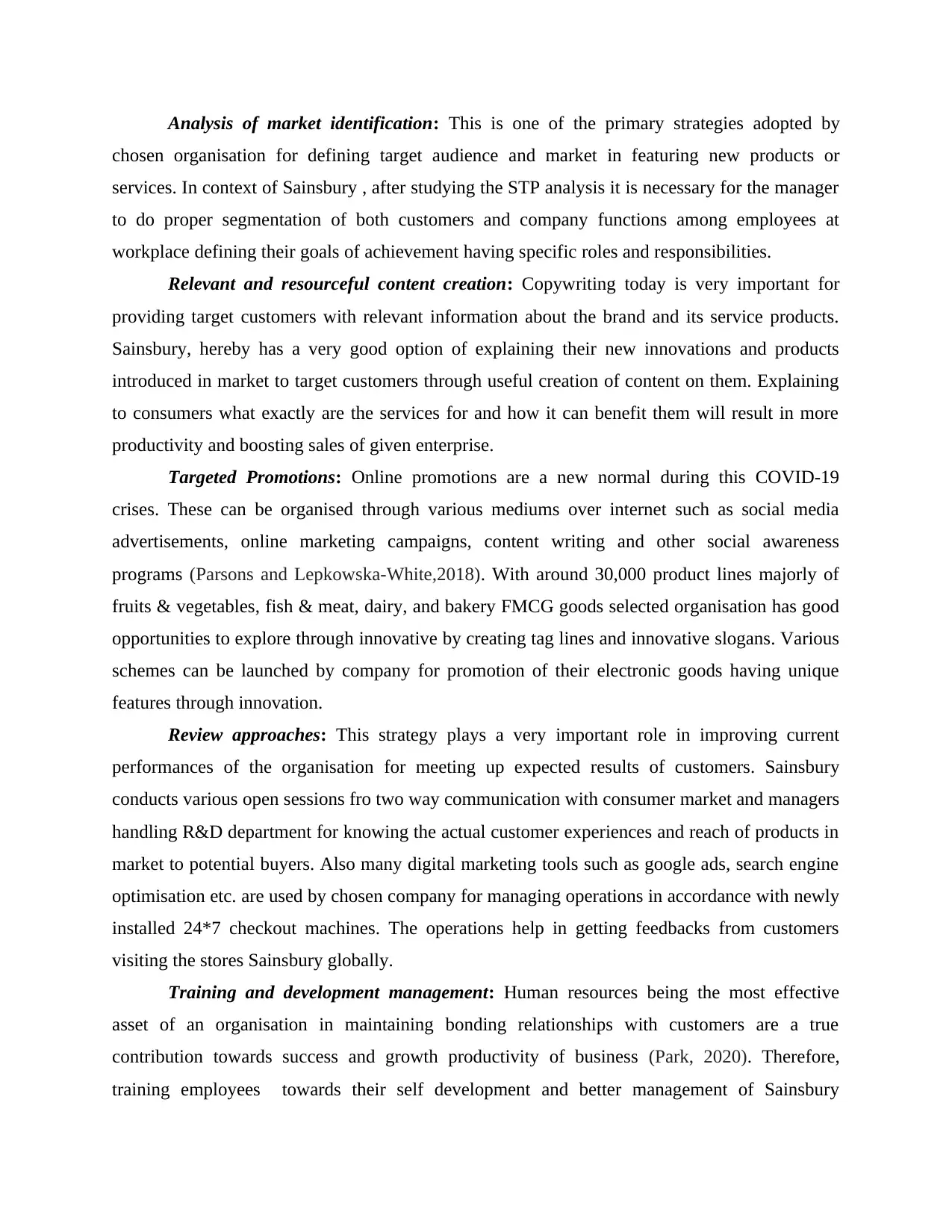
Analysis of market identification: This is one of the primary strategies adopted by
chosen organisation for defining target audience and market in featuring new products or
services. In context of Sainsbury , after studying the STP analysis it is necessary for the manager
to do proper segmentation of both customers and company functions among employees at
workplace defining their goals of achievement having specific roles and responsibilities.
Relevant and resourceful content creation: Copywriting today is very important for
providing target customers with relevant information about the brand and its service products.
Sainsbury, hereby has a very good option of explaining their new innovations and products
introduced in market to target customers through useful creation of content on them. Explaining
to consumers what exactly are the services for and how it can benefit them will result in more
productivity and boosting sales of given enterprise.
Targeted Promotions: Online promotions are a new normal during this COVID-19
crises. These can be organised through various mediums over internet such as social media
advertisements, online marketing campaigns, content writing and other social awareness
programs (Parsons and Lepkowska-White,2018). With around 30,000 product lines majorly of
fruits & vegetables, fish & meat, dairy, and bakery FMCG goods selected organisation has good
opportunities to explore through innovative by creating tag lines and innovative slogans. Various
schemes can be launched by company for promotion of their electronic goods having unique
features through innovation.
Review approaches: This strategy plays a very important role in improving current
performances of the organisation for meeting up expected results of customers. Sainsbury
conducts various open sessions fro two way communication with consumer market and managers
handling R&D department for knowing the actual customer experiences and reach of products in
market to potential buyers. Also many digital marketing tools such as google ads, search engine
optimisation etc. are used by chosen company for managing operations in accordance with newly
installed 24*7 checkout machines. The operations help in getting feedbacks from customers
visiting the stores Sainsbury globally.
Training and development management: Human resources being the most effective
asset of an organisation in maintaining bonding relationships with customers are a true
contribution towards success and growth productivity of business (Park, 2020). Therefore,
training employees towards their self development and better management of Sainsbury
chosen organisation for defining target audience and market in featuring new products or
services. In context of Sainsbury , after studying the STP analysis it is necessary for the manager
to do proper segmentation of both customers and company functions among employees at
workplace defining their goals of achievement having specific roles and responsibilities.
Relevant and resourceful content creation: Copywriting today is very important for
providing target customers with relevant information about the brand and its service products.
Sainsbury, hereby has a very good option of explaining their new innovations and products
introduced in market to target customers through useful creation of content on them. Explaining
to consumers what exactly are the services for and how it can benefit them will result in more
productivity and boosting sales of given enterprise.
Targeted Promotions: Online promotions are a new normal during this COVID-19
crises. These can be organised through various mediums over internet such as social media
advertisements, online marketing campaigns, content writing and other social awareness
programs (Parsons and Lepkowska-White,2018). With around 30,000 product lines majorly of
fruits & vegetables, fish & meat, dairy, and bakery FMCG goods selected organisation has good
opportunities to explore through innovative by creating tag lines and innovative slogans. Various
schemes can be launched by company for promotion of their electronic goods having unique
features through innovation.
Review approaches: This strategy plays a very important role in improving current
performances of the organisation for meeting up expected results of customers. Sainsbury
conducts various open sessions fro two way communication with consumer market and managers
handling R&D department for knowing the actual customer experiences and reach of products in
market to potential buyers. Also many digital marketing tools such as google ads, search engine
optimisation etc. are used by chosen company for managing operations in accordance with newly
installed 24*7 checkout machines. The operations help in getting feedbacks from customers
visiting the stores Sainsbury globally.
Training and development management: Human resources being the most effective
asset of an organisation in maintaining bonding relationships with customers are a true
contribution towards success and growth productivity of business (Park, 2020). Therefore,
training employees towards their self development and better management of Sainsbury
⊘ This is a preview!⊘
Do you want full access?
Subscribe today to unlock all pages.

Trusted by 1+ million students worldwide
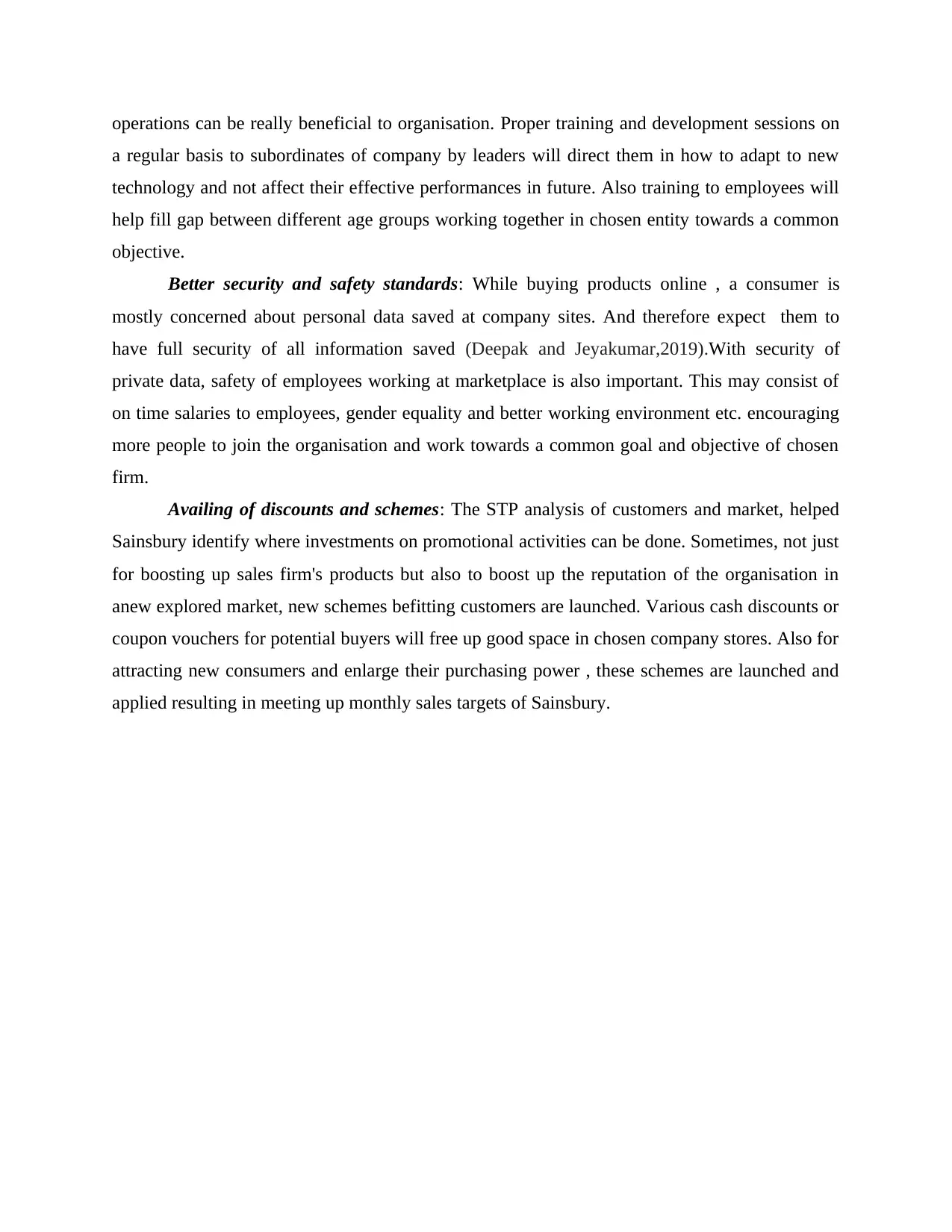
operations can be really beneficial to organisation. Proper training and development sessions on
a regular basis to subordinates of company by leaders will direct them in how to adapt to new
technology and not affect their effective performances in future. Also training to employees will
help fill gap between different age groups working together in chosen entity towards a common
objective.
Better security and safety standards: While buying products online , a consumer is
mostly concerned about personal data saved at company sites. And therefore expect them to
have full security of all information saved (Deepak and Jeyakumar,2019).With security of
private data, safety of employees working at marketplace is also important. This may consist of
on time salaries to employees, gender equality and better working environment etc. encouraging
more people to join the organisation and work towards a common goal and objective of chosen
firm.
Availing of discounts and schemes: The STP analysis of customers and market, helped
Sainsbury identify where investments on promotional activities can be done. Sometimes, not just
for boosting up sales firm's products but also to boost up the reputation of the organisation in
anew explored market, new schemes befitting customers are launched. Various cash discounts or
coupon vouchers for potential buyers will free up good space in chosen company stores. Also for
attracting new consumers and enlarge their purchasing power , these schemes are launched and
applied resulting in meeting up monthly sales targets of Sainsbury.
a regular basis to subordinates of company by leaders will direct them in how to adapt to new
technology and not affect their effective performances in future. Also training to employees will
help fill gap between different age groups working together in chosen entity towards a common
objective.
Better security and safety standards: While buying products online , a consumer is
mostly concerned about personal data saved at company sites. And therefore expect them to
have full security of all information saved (Deepak and Jeyakumar,2019).With security of
private data, safety of employees working at marketplace is also important. This may consist of
on time salaries to employees, gender equality and better working environment etc. encouraging
more people to join the organisation and work towards a common goal and objective of chosen
firm.
Availing of discounts and schemes: The STP analysis of customers and market, helped
Sainsbury identify where investments on promotional activities can be done. Sometimes, not just
for boosting up sales firm's products but also to boost up the reputation of the organisation in
anew explored market, new schemes befitting customers are launched. Various cash discounts or
coupon vouchers for potential buyers will free up good space in chosen company stores. Also for
attracting new consumers and enlarge their purchasing power , these schemes are launched and
applied resulting in meeting up monthly sales targets of Sainsbury.
Paraphrase This Document
Need a fresh take? Get an instant paraphrase of this document with our AI Paraphraser
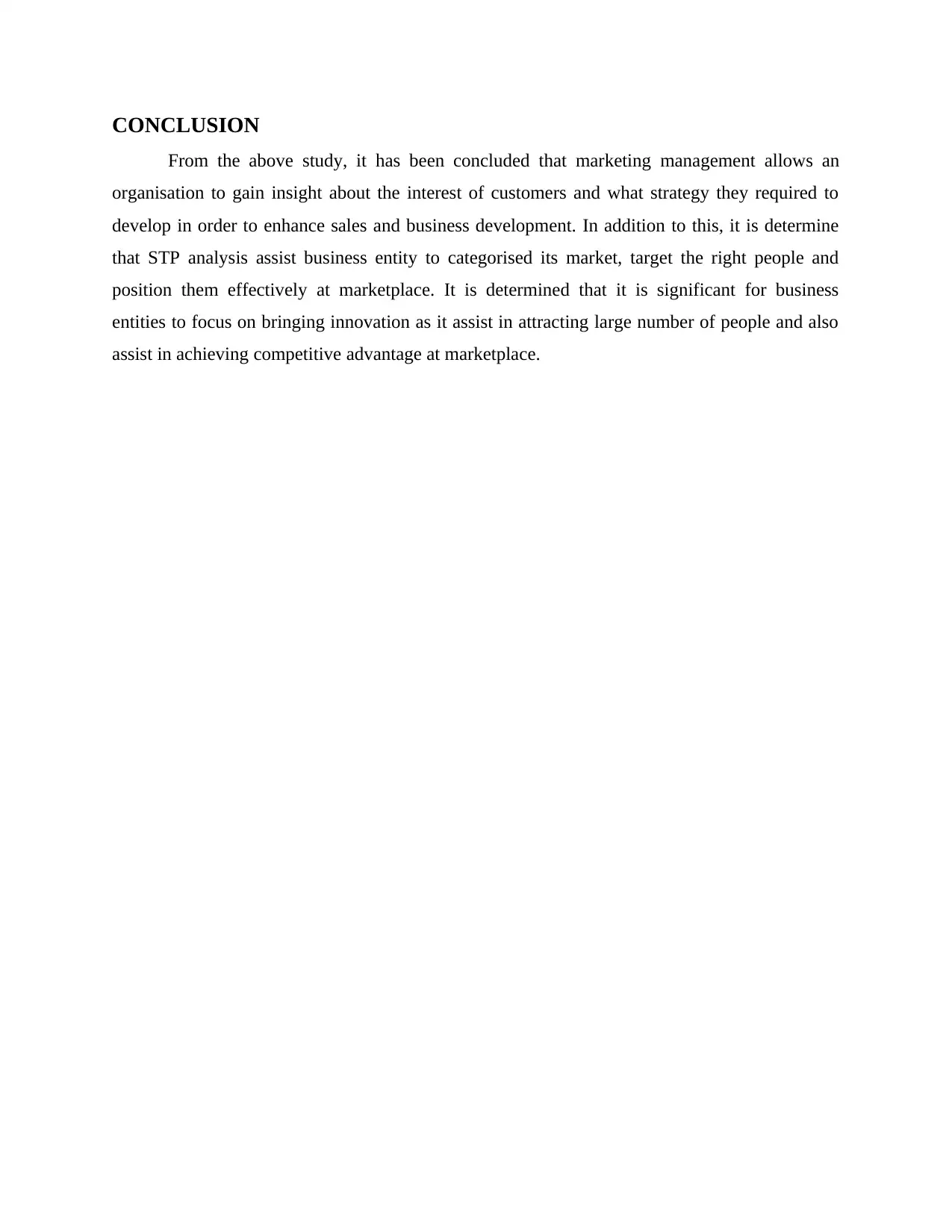
CONCLUSION
From the above study, it has been concluded that marketing management allows an
organisation to gain insight about the interest of customers and what strategy they required to
develop in order to enhance sales and business development. In addition to this, it is determine
that STP analysis assist business entity to categorised its market, target the right people and
position them effectively at marketplace. It is determined that it is significant for business
entities to focus on bringing innovation as it assist in attracting large number of people and also
assist in achieving competitive advantage at marketplace.
From the above study, it has been concluded that marketing management allows an
organisation to gain insight about the interest of customers and what strategy they required to
develop in order to enhance sales and business development. In addition to this, it is determine
that STP analysis assist business entity to categorised its market, target the right people and
position them effectively at marketplace. It is determined that it is significant for business
entities to focus on bringing innovation as it assist in attracting large number of people and also
assist in achieving competitive advantage at marketplace.
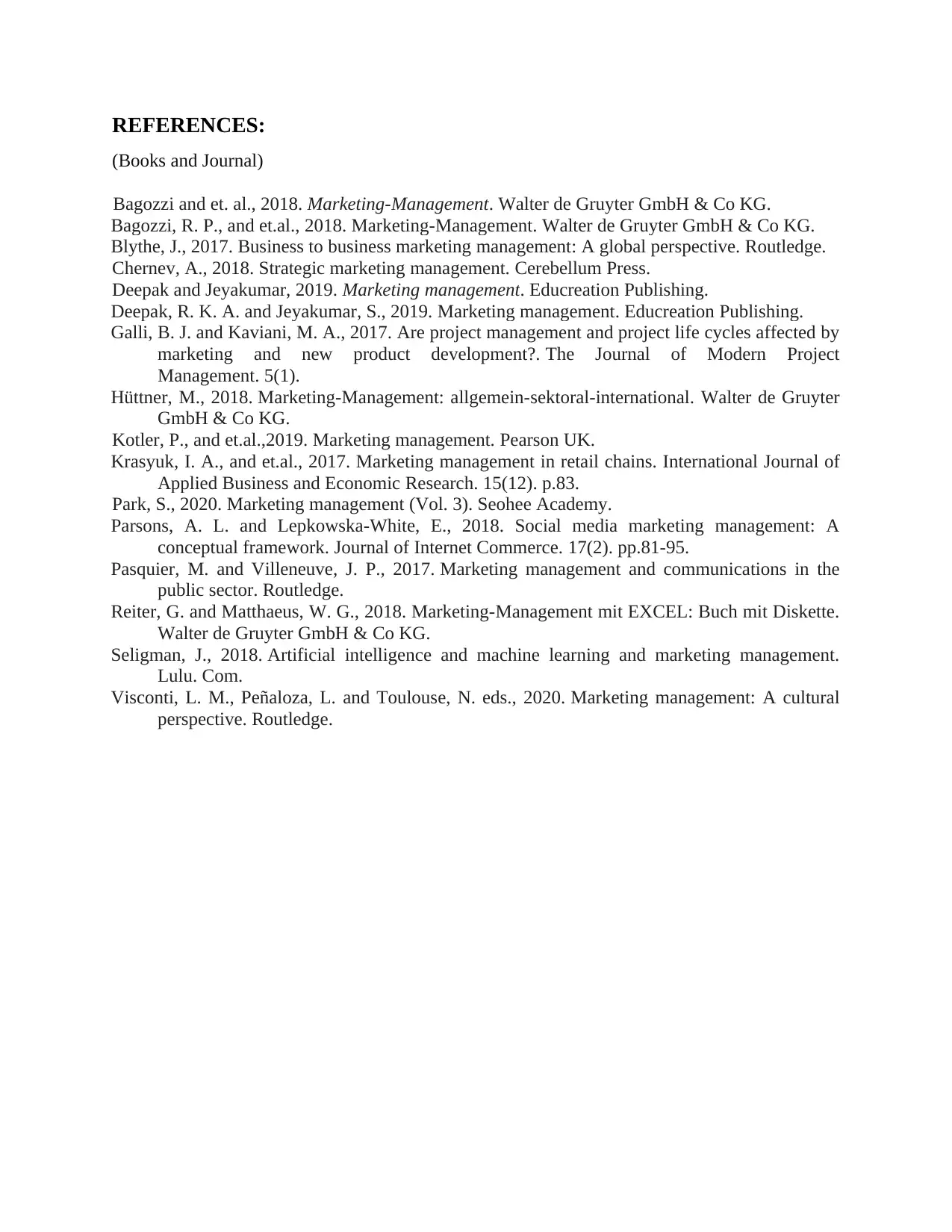
REFERENCES:
(Books and Journal)
Bagozzi and et. al., 2018. Marketing-Management. Walter de Gruyter GmbH & Co KG.
Bagozzi, R. P., and et.al., 2018. Marketing-Management. Walter de Gruyter GmbH & Co KG.
Blythe, J., 2017. Business to business marketing management: A global perspective. Routledge.
Chernev, A., 2018. Strategic marketing management. Cerebellum Press.
Deepak and Jeyakumar, 2019. Marketing management. Educreation Publishing.
Deepak, R. K. A. and Jeyakumar, S., 2019. Marketing management. Educreation Publishing.
Galli, B. J. and Kaviani, M. A., 2017. Are project management and project life cycles affected by
marketing and new product development?. The Journal of Modern Project
Management. 5(1).
Hüttner, M., 2018. Marketing-Management: allgemein-sektoral-international. Walter de Gruyter
GmbH & Co KG.
Kotler, P., and et.al.,2019. Marketing management. Pearson UK.
Krasyuk, I. A., and et.al., 2017. Marketing management in retail chains. International Journal of
Applied Business and Economic Research. 15(12). p.83.
Park, S., 2020. Marketing management (Vol. 3). Seohee Academy.
Parsons, A. L. and Lepkowska-White, E., 2018. Social media marketing management: A
conceptual framework. Journal of Internet Commerce. 17(2). pp.81-95.
Pasquier, M. and Villeneuve, J. P., 2017. Marketing management and communications in the
public sector. Routledge.
Reiter, G. and Matthaeus, W. G., 2018. Marketing-Management mit EXCEL: Buch mit Diskette.
Walter de Gruyter GmbH & Co KG.
Seligman, J., 2018. Artificial intelligence and machine learning and marketing management.
Lulu. Com.
Visconti, L. M., Peñaloza, L. and Toulouse, N. eds., 2020. Marketing management: A cultural
perspective. Routledge.
(Books and Journal)
Bagozzi and et. al., 2018. Marketing-Management. Walter de Gruyter GmbH & Co KG.
Bagozzi, R. P., and et.al., 2018. Marketing-Management. Walter de Gruyter GmbH & Co KG.
Blythe, J., 2017. Business to business marketing management: A global perspective. Routledge.
Chernev, A., 2018. Strategic marketing management. Cerebellum Press.
Deepak and Jeyakumar, 2019. Marketing management. Educreation Publishing.
Deepak, R. K. A. and Jeyakumar, S., 2019. Marketing management. Educreation Publishing.
Galli, B. J. and Kaviani, M. A., 2017. Are project management and project life cycles affected by
marketing and new product development?. The Journal of Modern Project
Management. 5(1).
Hüttner, M., 2018. Marketing-Management: allgemein-sektoral-international. Walter de Gruyter
GmbH & Co KG.
Kotler, P., and et.al.,2019. Marketing management. Pearson UK.
Krasyuk, I. A., and et.al., 2017. Marketing management in retail chains. International Journal of
Applied Business and Economic Research. 15(12). p.83.
Park, S., 2020. Marketing management (Vol. 3). Seohee Academy.
Parsons, A. L. and Lepkowska-White, E., 2018. Social media marketing management: A
conceptual framework. Journal of Internet Commerce. 17(2). pp.81-95.
Pasquier, M. and Villeneuve, J. P., 2017. Marketing management and communications in the
public sector. Routledge.
Reiter, G. and Matthaeus, W. G., 2018. Marketing-Management mit EXCEL: Buch mit Diskette.
Walter de Gruyter GmbH & Co KG.
Seligman, J., 2018. Artificial intelligence and machine learning and marketing management.
Lulu. Com.
Visconti, L. M., Peñaloza, L. and Toulouse, N. eds., 2020. Marketing management: A cultural
perspective. Routledge.
⊘ This is a preview!⊘
Do you want full access?
Subscribe today to unlock all pages.

Trusted by 1+ million students worldwide
1 out of 12
Related Documents
Your All-in-One AI-Powered Toolkit for Academic Success.
+13062052269
info@desklib.com
Available 24*7 on WhatsApp / Email
![[object Object]](/_next/static/media/star-bottom.7253800d.svg)
Unlock your academic potential
Copyright © 2020–2025 A2Z Services. All Rights Reserved. Developed and managed by ZUCOL.





